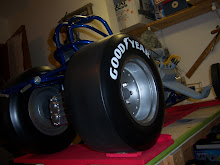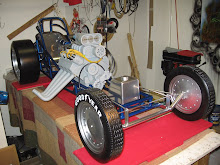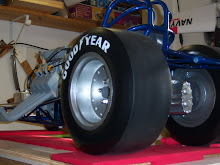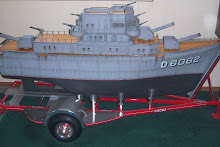 A common misconception is that I spend a lot of my time "bendin' wood"....although it's possible, it's not very practical in most situations. There's usually a simple solution to most problems. All of these projects are in the back of my mind regardless of what I'm working on, and there might be several different way to go about it. My attitude is "I guess I'll figure it out when I get to that point".
A common misconception is that I spend a lot of my time "bendin' wood"....although it's possible, it's not very practical in most situations. There's usually a simple solution to most problems. All of these projects are in the back of my mind regardless of what I'm working on, and there might be several different way to go about it. My attitude is "I guess I'll figure it out when I get to that point".Tubing or PVC is the most logical solution, and that's what I ended up using on the dragster. In the end it was the best way to go, however, bending plastic presents it own set of problems.
With the F/C I really wanted to use as much wood as possible, within reason. It's just a personal preference, but on the other hand I'll use whatever it takes to get the job done in the end.
After some trial and error, I settled on dowelrod. Each tube consisted of two separate pieces of wood. After both lengths were cut, a 45 degree angle was made on each end. A quick jig was built to ensure that all the tubes were exactly the same when glued up. After all 8 pieces were done, another vertical jig was built to drill the short end of the tube. This was quite tricky!
After some trial and error, I settled on dowelrod. Each tube consisted of two separate pieces of wood. After both lengths were cut, a 45 degree angle was made on each end. A quick jig was built to ensure that all the tubes were exactly the same when glued up. After all 8 pieces were done, another vertical jig was built to drill the short end of the tube. This was quite tricky!

In hindsight, I should've drilled the ends before the two pieces were joined. After several test pieces, I was fairly confident I could drill them without screwing up the entire tube. Using a large Paddle Bit, each piece was drilled as deep as possible without breaking the thin tubing that remained. I decided that 1" was deep enough. A good jig was really important here as a little bit of slop would've been disastrous. After the drilling was complete, a layer of 5 min. epoxy was applied to strengthen the thin wall of the tube.
The next step was to create the curve in the bends. At this point the tube looks like a letter L. The outside corner was ground down to the determined radius, then the inside corner was filled with scrap wood and Bondo to complete the bend.....pretty simple huh?
Another jig was built to hold all the tubes in place to the shape of the final header. The short ends were glued together, and the long ends were marked to cut at the correct angle. The mounting plate was added last to make it a strong structure.

Bending PVC creates another set of problems, the worst being that the bend wants to collapse in on itself. After quite a bit of trial and error, I ended up putting a piece of large electrical wire inside the tube, heating it to the point of failure, then putting it in a jig while it was still hot. This works only if you can get the wire back out after its cooled down. Liquid dish soap turned out to be the best solution. Later on I read a technique were the tube is filled with sand, capped on both ends and then bent. Seems like it should work, but I haven't tried it yet. The rest of it was built basically like the F/C headers.
My next try will probably be a crazy set of collectors for the 34' coupe. The sand filled tube idea might work well in this situation.










No comments:
Post a Comment